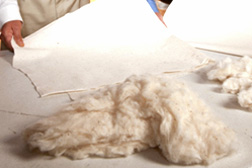This page has been archived and is being provided for reference purposes only. The page is no longer being updated, and therefore, links on the page may be invalid.
| Read the magazine story to find out more. |
|
|
|
|
Cotton's Potential for Padding Nonwovens
By Rosalie Marion BlissSeptember 9, 2011
U.S. Department of Agriculture (USDA) scientists have conducted studies to investigate the use of virgin cotton in nonwoven materials and products. The work was led by cotton technologist Paul Sawhney and his colleagues at the Agricultural Research Service (ARS) Cotton Chemistry and Utilization Research Unit in the agency's Southern Regional Research Center (SRRC) in New Orleans, La.
Sawhney is the lead scientist of the cotton-based nonwovens research program at the center. ARS is USDA's chief intramural scientific research agency.
Raw, virgin lint, which is ginned cotton that has not been washed and bleached, is referred to by the industry as "greige" cotton (pronounced "grey" cotton). Virgin cotton is considered less expensive and less complex to process compared to bleached cotton or other synthetics.
About 98 percent of cotton produced worldwide is used in traditional woven textiles. Nonwovens are made of tangled fibers and are produced in a continuous-sheet form at a relatively faster rate compared to that of woven fabrics. At first, nonwoven fabrics were made using only synthetic polymer-type fibers. As nonwovens fabric materials became more popular, some manufacturers began adding cotton.
The SRRC has added nonwoven machinery and equipment to its Cotton Nonwovens Research Laboratory and Pilot Facility. Studies showed that ginned virgin cotton could be processed directly on some traditional cotton fiber equipment. The cotton's natural waxes provided a measure of lubrication that was beneficial, when compared to bleached cotton fibers similarly processed.
The researchers also successfully processed the virgin cotton on the center's newer nonwoven fabrics production equipment. For example, the team found that greige cotton, which is naturally water repellent, can be made absorbent mainly by controlling the water pressure that entangles fibers during processing.
The researchers' findings have been published in Textile Research Journal.
Read more about this research in the September 2011 issue of Agricultural Research magazine.

